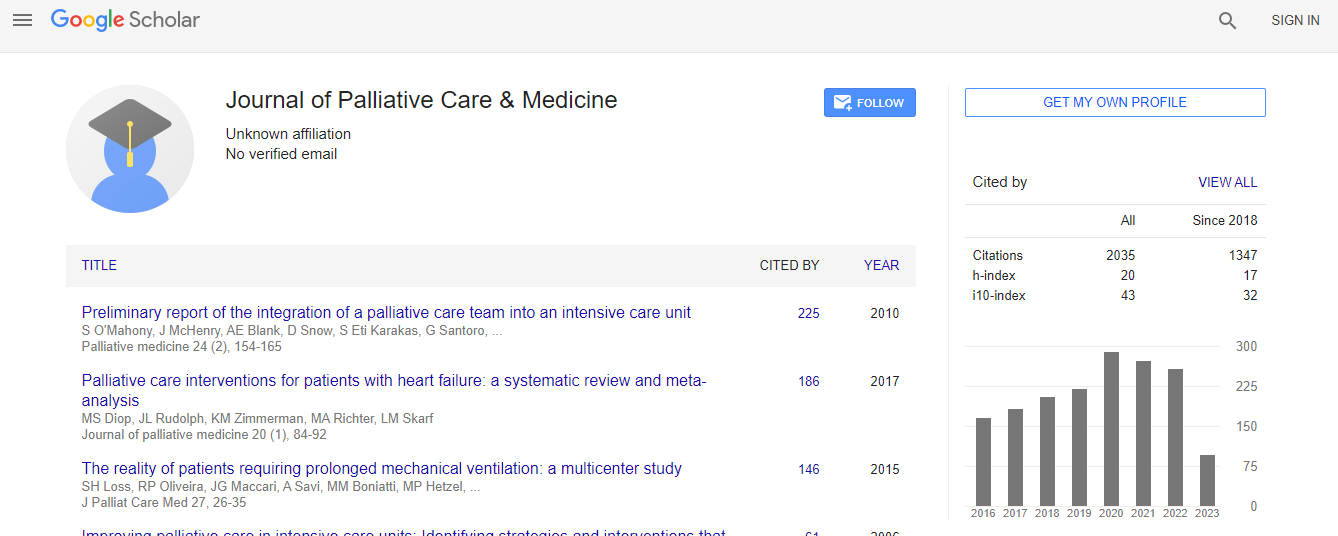Our Group organises 3000+ Global Conferenceseries Events every year across USA, Europe & Asia with support from 1000 more scientific Societies and Publishes 700+ Open Access Journals which contains over 50000 eminent personalities, reputed scientists as editorial board members.
Open Access Journals gaining more Readers and Citations
700 Journals and 15,000,000 Readers Each Journal is getting 25,000+ Readers
Google Scholar citation report
Citations : 1689
Journal of Palliative Care & Medicine received 1689 citations as per Google Scholar report
Journal of Palliative Care & Medicine peer review process verified at publons
Indexed In
- Index Copernicus
- Google Scholar
- Open J Gate
- Genamics JournalSeek
- China National Knowledge Infrastructure (CNKI)
- Electronic Journals Library
- RefSeek
- Hamdard University
- EBSCO A-Z
- OCLC- WorldCat
- Virtual Library of Biology (vifabio)
- Publons
- Geneva Foundation for Medical Education and Research
- Euro Pub
- ICMJE
Useful Links
Recommended Journals
Related Subjects
Share This Page
Beating heart does not always mean life. A challenging dilemma for palliative care and bioethics in the era of advanced critical care
International Conference on Hospice & Palliative Care
Waqas Nawaz, Sania Sultana and Jessica Tsukanov
Albert Einstein College of Medicine, USA
Posters-Accepted Abstracts: Posters-Accepted Abstracts
Abstract
Introduction: Brain death is defined as the irreversible loss of all functions of the brain, including the brainstem. In palliative and critical care medicine, brain death without cardiac death has always been a challenging dilemma due to inability of general population to differentiate it from coma. Here we describe a case of 50 year old female where lag of 7 days between brain and cardiac death offered significant challenge to the physicians and enormous emotional trauma to the family. Materials & Methods: Case describes 50 year old female who had a cardiac arrest, was resuscitated and in tubated in ICU where she was started on vasopressors. Neurological exam and CT head showed loss of differentiation between grey and white matter consistent with anoxic brain injury. Neurological exam revealed absent brainstem reflexes suggesting possible brain death. The husband was explained about the concept of brain death. Brain death was confirmed by neurologist. She was not considered a candidate for apnea test given high PEEP requirements on ventilator. Brain perfusion scan and EEG were consistent with diagnosis of brain death. She was pronounced legally dead and death certificate was completed. Husband stated 2 previous such incidences in the family where patient recovered few months after being in ��?coma.� He did not accept her death and requested to continue with life support. Palliative care and bioethics were involved and family meetings with the husband and children were arranged where they were explained the difference between coma and death. They insisted upon continuing with life support and ��?full code� status in the event of cardiac arrest. They were explained that there is no such thing as code status once a patient is brain dead. The family did not accept her death due to her heart beat, some visible muscle twitching due to spinal reflexes and their religious views in spite of all medical explanation and counseling. Hospital administration, risk management, bioethics and palliative care were involved actively. Pastoral care was also provided respecting their religious views. 6 days later, the family reached upon a decision where they all agreed to discontinue the life support. They were given permission to attend the extubation that was immediately followed by cardiac death. Psychosocial and moral support was provided. Discussion: Brain death without cardiac death is not an uncommon entity in the era of advanced critical care but remains debatable as it is imbued with social, cultural, and religious meaning. It is a clinical diagnosis that requires the establishment of the cause of coma, the ascertainment of irreversibility, the recognition of possible confounding factors (e.g. hypothermia, barbiturate poisoning etc.) and the apnea test. Advanced neurological tests like cerebral scintigraphy, EEG, trans-cranial Doppler and cerebral angiography are indicated to confirm the diagnosis if apnea test cannot be done. Brain death is followed by cardiac death within6-7days in 97% of cases. Death certificate is done at the time of diagnosis of brain death and is dated and timed accordingly with comprehensive documentation. The organ donor network is contacted at the time of brain death. Two physicians are required to certify the time of death in case of organ donation. Conclusions: Brain death is a clinical diagnosis that requires sancillary tests only in certain circumstances. Brain death is often not accepted by the family due to resemblance with coma, general concept of life with heart beat and religious beliefs. Cardiorespiratory support should be withdrawn in accordance with hospital policies, including those for organ donation.Biography
Waqas Nawaz got his MBBS from King Edward Medical University in the year 2010. He is a resident physician under the category of PGY3 in Internal Medicine Department at Montefiore Medical Centre, Wakefield Campus, New York which will conclude in June 2016. He has published 10 clinical abstracts and several academic achievements. He is currently working at Montefiore Medical Campus with previous experiences from Carthage Area Hospital (Watertown, New York) and Mayo Hospital, Lahore.
Email: waqasnawaz777@yahoo.com

 Spanish
Spanish  Chinese
Chinese  Russian
Russian  German
German  French
French  Japanese
Japanese  Portuguese
Portuguese  Hindi
Hindi 
